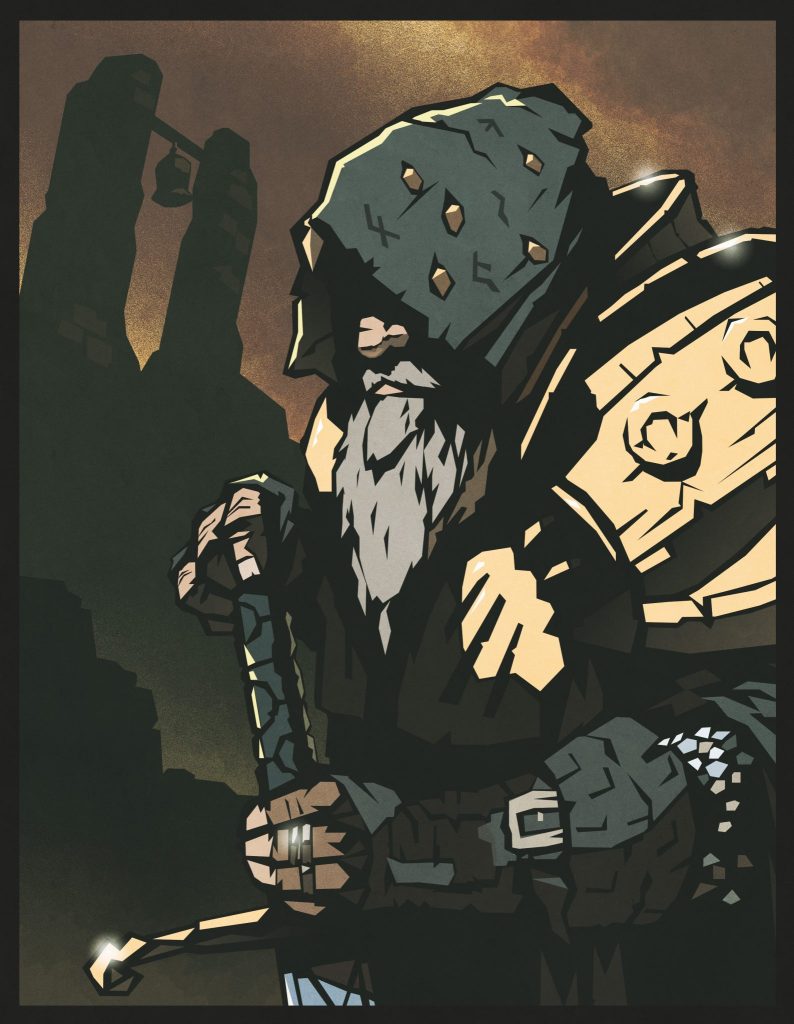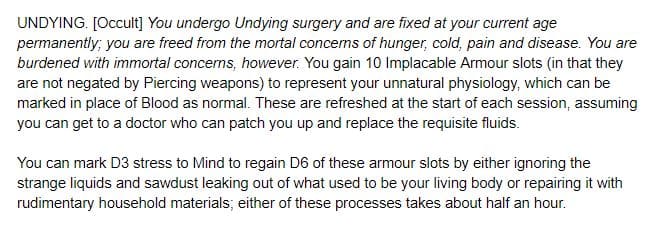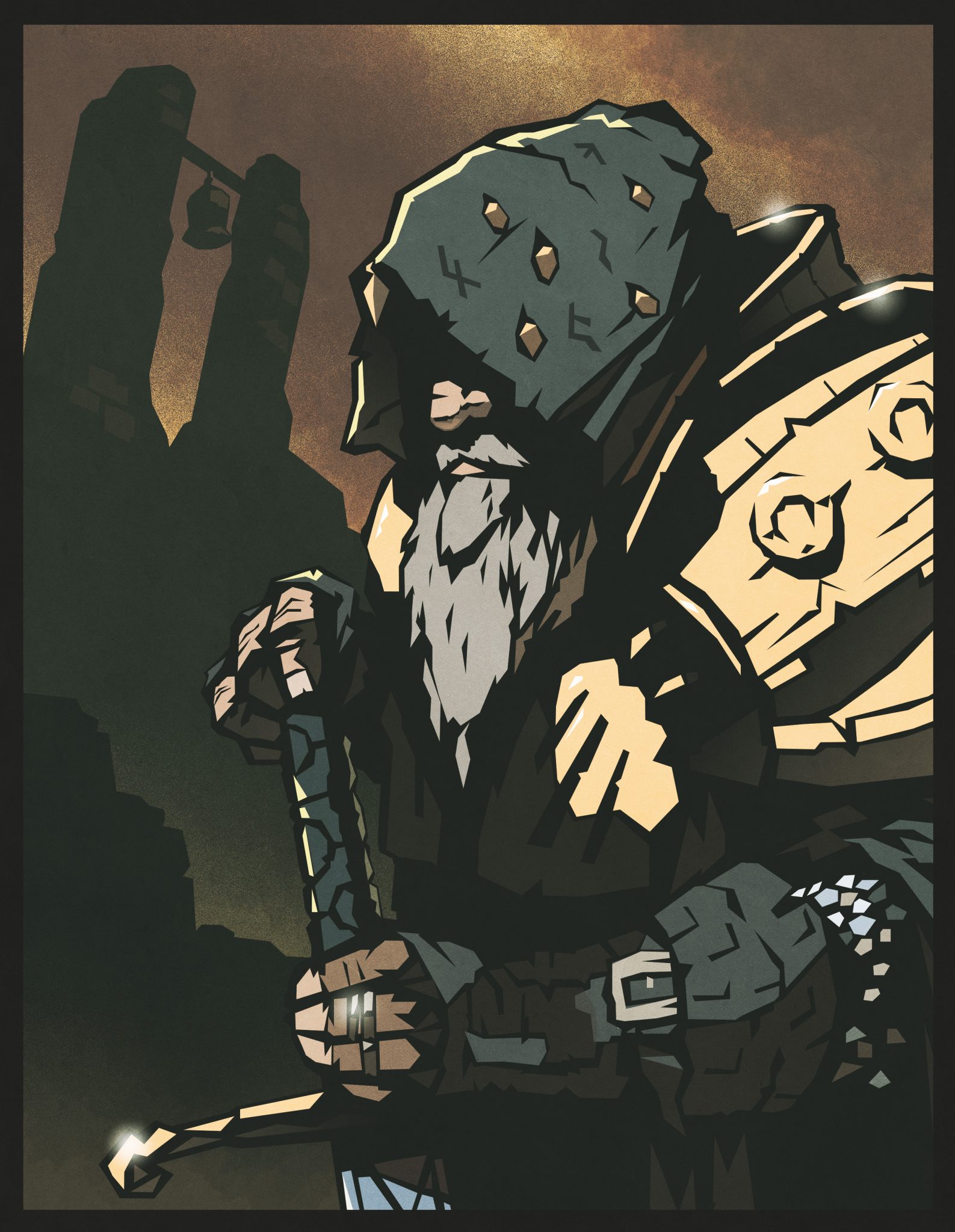“As punishment for your crimes, the city of Spire has declared you dead – and it falls to me to correct the administrative imbalance that sees you standing here, alive, breathing, in flagrant violation of several crucial edicts and one Grand Statute.”
Executions are illegal in Spire thanks to a law instituted over a century ago by a Legislator-Architect who found them unfashionable. However, the influential Mortician sect were able to find a loophole around the ban – declaring a person legally dead and then redressing the balance at swordpoint. You are a Mortician Executioner, and you have joined the Ministry of our Hidden Mistress; you live a double life as a state assassin and a revolutionary, and must shoulder all the burdens that brings.

The Mortician Executioner has been following us around for a while. (Not in real life, you understand: that would be terrifying.) They were one of the original Spire classes, back when the game had a Control stat for every fight, a Black Bag skill and used, god, playing cards or something to resolve challenges or something. We knew that we wanted a death magician, but they kept skewing too close to being in authority for us, and we couldn’t come up with enough interesting abilities to make them work properly so we shuffled them off to one side and forgot about them for four years.
And now! Here we are, older and wiser, with a better understanding of what Spire is about and hundreds of hours of games design experience under our collective belt. We figured we’d have another go at the Executioner, because it would be interesting to take a look at death (and the administration of same) through the lens of a culture that differs from the Carrion-Priest in the core book.
OVERVIEW
All told, the Executioner is a joke that got out of hand. We liked the idea of state executions being illegal but declaring someone dead and then correcting the real-world inaccuracy with murder being perfectly legal, because that’s the kind of Kafkaesque gag that fits perfectly into the black humour of Spire. In practice, it’s actually been really hard to work with, because the murderous insouciance of the aelfir has resulted in a lot of in-canon executions which we’ve just sort of glossed over, but here we are.
Let’s address the elephant in the room: the Executioner is a cop.
The Knight is a sort of cop if you squint and don’t worry about the fact that the only badge they have is tattooed onto their arm. The Bound is a vigilante. But the Morticians are directly supported by the city and enforce state law, in as much as they kill enemies of the state (or anyone important enough to have that title thrust upon them via bribery), and they’re part of a vast and influential bureaucracy that controls vast swathes of land and power within Spire.
In short: not your average revolutionary. Which is another reason why we didn’t include them in the first book, because they felt too powerful and too in-charge to be interesting to play, especially when we had the refugee Carrion-Priests who were doing the same job and got a cool hyena to play with.
What we’ve tried to do with this class is underline the fact that the player character is undercover in the Morticians – they’re a state executioner, but given the lack of oversight applied to their actions, they have the ability to manipulate and abuse the systems of power from the inside to benefit the revolution. That’s why their refresh ability is focused not around doing their job, as in the case of a lot of the other classes, but about subverting challenges and turning them into tools to be used rather than destroying them. That’s one of the central themes of Spire – subvert, don’t destroy – and it was nice to be able to reward it directly.
EQUIPMENT
We’ve gone for two different flavours of Executioner using the starting equipment choices. Firstly there’s a witch-hunter, Inquisitor, cool-lookin’-guy-in-a-coat with a crossbow and an axe type; secondly, there’s the Russian-Orthodox-Priest-lookin’-guy who gets a big staff and a load of robes and holy symbols, who is more of a cleric. We spent a very long time researching names for particular kinds of holy attire (tippets, chasubels, kalimavkorai, etc) but most of them were so obscure or funny-looking to be of no use whatsoever, so we settled on “robes” and let you fill in the details yourself.
CORE ABILITIES
Once per situation, Executioners can automatically detect who in the immediate area knows what they want to know – getting it out of them is their problem, though. Hopefully this can speed up investigations and remove red herrings.
Crucially, once per session, they can declare someone legally dead. A few of their abilities key off this (see below) and they get increased combat capability against their target; they can mark extra people using this method, but doing so causes their Shadow stress to mount up as they risk discovery from their Mortician masters.
ABILITIES
The Executioner is a combat powerhouse, if you want them to be – they’re easily the equal of the Knight or the Carrion-Priest once they get up and running. Abilities like ONE DROW ARMY and REAPER’S TOUCH allow them to chop through whole groups of assailants at once:

Single targets aren’t safe either, thanks to DEATH’S KEEN BOLT:

Which, you’ll note, is great unless you actually kill anyone with it, at which point you get in trouble with your boss and have to start falsifying records to cover up the fact that it wasn’t shot at an enemy of the state but, in fact, an aelfir arms dealer who you decided was easier to deal with once they were dead.
But! Honestly? The combat bits are the less exciting part of the class compared to their MAGICAL BUREAUCRACY and CORPSE SURGERY abilities. We wanted to show that the Executioners aren’t just Judge Dredd-style badasses running around and killing people, but that they’re part of a larger organisation with its own rules, benefits and restrictions. For example, you can use SPEAK WITH “DEAD” to communicate with someone who’s legally dead but not actually dead:

Why? Because we thought it would be fun to distract someone with a ouija board and then steal their wallet, or pretend to be someone’s subconscious and see if you can’t trick a password out of them. You can also influence the city around them to reflect the fact that they’re no longer a living citizen, to make them late for things, because we’re really into that kind of petty evil here at RRD Towers. Channelling the bureaucracy of the dead in different ways allows them to recreate events from official reports or half-forgotten memories, erase Shadow stress and fallout, and even – once – swap out their own death for someone else’s.
The corpse surgery elements come from the way that the Morticians have developed Undying surgery – a necromantic practice that fixes you at your current age and renders you immortal but prone to madness, moth infestations, curious leakages, etc. We figured that we could play with the idea that they’ve managed to implant stuff in people that shouldn’t strictly be in there, which leads to audacious and fashionable implants such as visible organs behind glass, nonfunctional megacorvid wings, hands of glory, dead men’s eyes, and so on. Do well enough and you can get the full Undying package:

INSPIRATIONS
The Mortician-as-state-badass is undoubtedly inspired by Inquisitors from Warhammer 40k and the Witch Hunters of real-world history; we can’t say that we agree with their methods or their goals but there’s a lot of scary imagery and association to draw on, there.
And: you know how there’s, like, funny laws? Like “you can’t carry a pig under one arm in the market square on Sunday in Canterbury” or “in Zachariah, New Michigan you can’t marry a Frenchman unless your door is painted green,” that sort of thing? We like those. Or rather we like what they say about law – that it is infallible and strange and a purely social construct, and that once you step away from it for a hundred years or a hundred miles it can seem perverse and ridiculous.
That’s what the Executioner is – an extension of the ridiculous and a sack of ideas about death and bureaucracy and ritual tied up in a bag that’s trying to overthrow the government. They’re the most organically Spire class we’ve ever done, I think – they’ve arisen out of the fiction and become something more than they started as, and they fit really neatly into the overall whole of the game.

Great stuff RRD team! I’ve been fascinated by the ‘ol Morticians since they were first introduced in Spire – primarily as elite state-sponsored antagonists but also as an odd counterpoint to the wild Carrion Priests. Excited for the possibility of a party with both!
Thank you for sharing your design ideas and ethos on the blog!